#youshouldplay649
Brand Reawakening (SILVER)
Client Credits: Loto-Quebec
Agency Credits: Sid Lee
Sid Lee
Chief Creative: Alex Bernier
Strategy: Thomas Hougaz
Writing: Christopher Jones, Guillaume Bergeron
Art Director: Alexandre Pellerin, Marc Guilbault
Accounts: France Wong, Maude Barette, Camille Reed
Agency Producer: Katia Pellerin, Saskia Von Lignau
Production: BLVD
Direction: Sanchez Brothers
Editing: Hubert Hayaud
Director of Photography: Christophe Collette
Production: Alexandre Villeneuve, Jason Breton
Postproduction: Cadie Desbiens-Desmeules
Sound editing: Sylvain Roux
Media Compagny: PHD Montréal
Maxime Corriveau, Michèle Duchesneau
Section I — CASE PARAMETERS
| Business Results Period (Consecutive Months): | September 2015 – June 2016 |
| Start of Advertising/Communication Effort: | September 2015 |
| Base Period as a Benchmark: | September 2014 – October 2015 |
| Geographic Area: | Québec, Canada |
| Budget for this effort: | $1 – $2 million |
Section IA — CASE OVERVIEW
Why should this case win in the category (ies) you have entered?
Lotto 6/49 has re-emerged as a culturally relevant brand after a decade of losing its pertinence, sales, and ability to engage with 18-34 year olds.
We dug into Millennials’ philosophy of life and discovered their positive outlook on the future. The pivotal insight emerged when we put on our optimist millennial hat. The world became a place filled with luck. To stay true to the brand, we had to remain human and deeply rooted in Quebecers’ culture. Our big idea: When luck strikes in everyday life, people often say: “You should buy a lottery ticket”. Taking ownership of this phrase and building several narratives to bring it to life ignited a shift in momentum, reverting a decade-long downward trend in lottery sales among 18-34 year olds.
Through three powerful insights, breaking every rule of the category, we developed a platform that drastically increased Lotto 6/49 sales in Quebec among Millennials and the general population. Without showing what people could do with millions, we created a deep connection between consumers and a lottery product. Today, the expression “You should buy a 6/49” is anchored in popular culture. This campaign shows so many relatable everyday situations, that it became a social phenomenon.
Section II — THE CLIENT’s BUSINESS ISSUES/OPPORTUNITIES
a) Describe the Client’s business, competition and relevant history:
Lotto 6/49 is a pioneer:
Launched in June 1982, with a guaranteed jackpot of $500,000, Lotto 6/49 became the first nationwide Canadian lottery game to allow players to choose their own numbers. Loto-Québec is responsible for marketing and selling Lotto 6/49 in Quebec, while other provinces promote the same Lotto 6/49 in their own way to their own target segments. As the name implies, six numbers are drawn from a set of 49. A minimum of $5M is shared between the tickets with six winning numbers. Should there be no ticket with six winning numbers, the prize not won is added to the next jackpot.
A reference brand in a highly competitive market:
Lotto 6/49 reigned supreme until the introduction of Lotto Max in 2009. This new lottery guarantees at least $10M. Lotto Max is different from other lottery products, such as Lotto 6/49. Lotto Max requires seven winning numbers and tickets cost $5, while a Lotto 6/49 ticket is priced at $3, offering a more affordable option to players. Furthermore, Lotto Max is positioned as the lottery that enables people to realize their wildest dreams, while Lotto 6/49 is more grounded, more human, and more about everyday life situations. Such human positioning created deeper bonds with consumers and kept Lotto 6/49 close to Quebecers’ hearts. Nonetheless, the bond wasn’t strong enough to prevent cannibalization.
Evolving consumer trends:
There’s no doubt that the population is increasingly educated about probabilities and statistics. The younger generations simply do not believe they have a chance of winning a game with odds of 14 million to 1. Sales of Lotto 6/49 among Millennials have been drastically and systematically decreasing for the past 15 years[1]. Unfortunately, nothing has been able to stop the sales decrease, not even the introduction of a guaranteed 1 million prize at every draw.
The problem goes deeper and beyond the increased understanding of probabilities. Consumers, and more specifically, younger generations, stopped seeing the relevance of Lotto 6/49. No matter how big the prize or the dream we showcased in advertising, we wouldn’t get more traction from Millennials[2]. Of course, 18-34 year olds have dreams, but they would not see Lotto 6/49 as a means to realizing them. They are a generation of “makers”[3],[4] who are entrepreneurial and who believe they have control over their destiny. Their success must come from their hard work, their ideas, and their perseverance. Of course, they would not say no to millions of dollars, but the fact is that they would never count on a lottery ticket to reach their dreams.
b) Describe the Client’s Business Issues/Opportunities to be addressed by the campaign:
Identifying growth opportunity:
In 2014, 71% of Lotto 6/49 sales in Quebec came from players 50 and older. Among all Lotto 6/49 players, 35% were retired[5]. The vast majority of lottery products had not been able to conduct a generational transfer. Sales were decreasing at the same pace as baby boomers were leaving the end of the demographic charts.
Indeed, among 18-24 year olds, only 3% bought a Lotto 6/49 every four weeks or less, and 6% every three months or less. If we specifically look at those who played Lotto 6/49 every three months or less, 27% were Millennials, compared to 74% in 20115. The opportunity for Lotto 6/49 was more a question of survival by stopping a haemorrhage rather than an incremental growth occasion.
So what could we do?
There was no way we could make the product itself more attractive. Making prizes larger or more guaranteed wouldn’t make a difference in the eyes of Millennials. It was about a radical change in perspective. We needed to shift the way they perceived lottery games such as Lotto 6/49. We needed to break the rules of the category and create room for insights that would reconnect the younger generations with Lotto 6/49.
The question we needed to answer was quite challenging: How could we make Lotto 6/49 relevant to Millennials when they didn’t see the lottery as a means of reaching their dreams?
c) Resulting Business Objectives: Include how these will be measured:
The resulting business objective became clear and ambitious:
We aimed at avoiding a further decrease and stabilizing the number of Millennials at 27% among the “three months or less” Lotto 6/49 buyers. We were, optimistically, looking to reverse the trend and reach 30% of Millennials among the “three months or less” Lotto 6/49 buyers.
[1] 2004-2014. Loto-Québec. PEN. Étude de pénétration annuelle.
[2] 2014, Nick Shore. MTV Insights. Millennials: The New American Dreamers. MTV Insight Research blog.
[3] 2014. Tim Bajarin. Time. Why the Maker Movement Is Important to America’s Future.
[4] 2013. Brit Morin. The Huffington Post. What Is the Maker Movement and Why Should You Care?
[5] 2014. SOM Recherche et sondages pour Loto-Québec. PEN. Étude de pénétration annuelle.
Section III — YOUR STRATEGIC THINKING
a) What new learnings/insights did you uncover?
The target consumer:
In order to reposition Lotto 6/49 to attract Millennials, we needed to better understand their relationship with lotteries in general. We soon discovered Millennials are an amazingly positive generation. They are often referred to as “makers”, which implies they are entrepreneurial. They believe in their talent to build things. They are neither fatalists nor pessimists. They believe they have the power to change things. Among other traits, such as their sociability and their will to work on projects that matter to them, they believe it’s possible to make the world a better place. The first relevant insight we unveiled is that they are optimists. They see the glass half-full and not half-empty.
The pivotal insight:
First, we thought the answer could be found in a better understanding of Millennials’ relationships with the lottery. This hypothesis led us to much deeper and more interesting questions about their perceptions of luck. Focusing on their optimism made us realize our assumption about their relationship with probabilities was completely false. We portrayed them as a generation that doesn’t believe in luck and in odds, and consequently, in the lottery.
The pivotal insight emerged when we put on our optimist millennial hat. The world became a place filled with luck. It is everywhere and it happens all the time. We meet our husbands and wives by chance. We get spared from unpleasant situations out of luck. As a matter of fact, big or small, life’s most beautiful things happen by chance. And if we truly think about the extent of this insight, we can look back and appreciate the fact that we have been lucky since day one. Indeed, we are all lucky.
b) What was your Big Idea?
The big idea, as presented to the Loto-Québec marketing team, was to make the younger generations realize that everyday life is full of lucky moments, and when those moments arrive, we all use the expression “You should buy a lottery ticket”.
c) How did your Communication strategy evolve?
Crafting a new positioning from a pivotal insight:
In order to meaningfully connect Millennials with Lotto 6/49, we needed to find a strong connection between Lotto 6/49 and the pivotal insight, which suggests that luck is everywhere. In order to find that link, we went back to the positioning and DNA of Lotto 6/49. We had positioned it as a lottery more grounded, more human, and more into everyday life situations. And that’s when the third insight emerged. When luck strikes in an everyday life situation, people usually say: “You should buy a lottery ticket”. This expression transcends generations and is popular in Canada, the United States, and every other country.
Reawakening the brand using a pivotal insight:
Until 2009, Lotto 6/49’s brand signature was “Always be nice to people who play Lotto 6/49.” It was a clever way to remind people that those who play win big, and those who don’t play are missing out. The human tone and behaviour of the Lotto 6/49 brand was somewhat relevant to consumers. However, the brand promise was still about the jackpot, the dream, and the possibility of a better life.
In order to reawaken the Lotto 6/49 brand, we stopped basing communications on the jackpot, the dream, and the possibility of a better life. It was a tough decision to make because they are the pillars of every single lottery brand. Instead, we focused on the pivotal insights we had uncovered; suggesting that luck is part of everyone’s daily life.
That being said, we had to maintain the deeper human aspect and authentic DNA of Lotto 6/49. Therefore, we decided to keep it grounded, human, and rooted in Quebecers’ everyday life situations.
d) How did you anticipate the communication would achieve the Business Objectives?
X
Section IV — THE WORK
a) How, where and when did you execute it?
a) Key executional elements
- Television: 6×15 seconds TVC executions
- Radio: stunt on 12/12 at 12:12 pm in partnership with Cogeco
- OOH: digital billboards inviting people to make wishes at 11:11, 12:12, 1:11, 2:22, etc.
- Digital media: banners (take over, big box, banners), SEM (search engine management)
- Social networks: contest in which over 1,000 people shared their lucky stories using the hashtag #youshouldbuya649
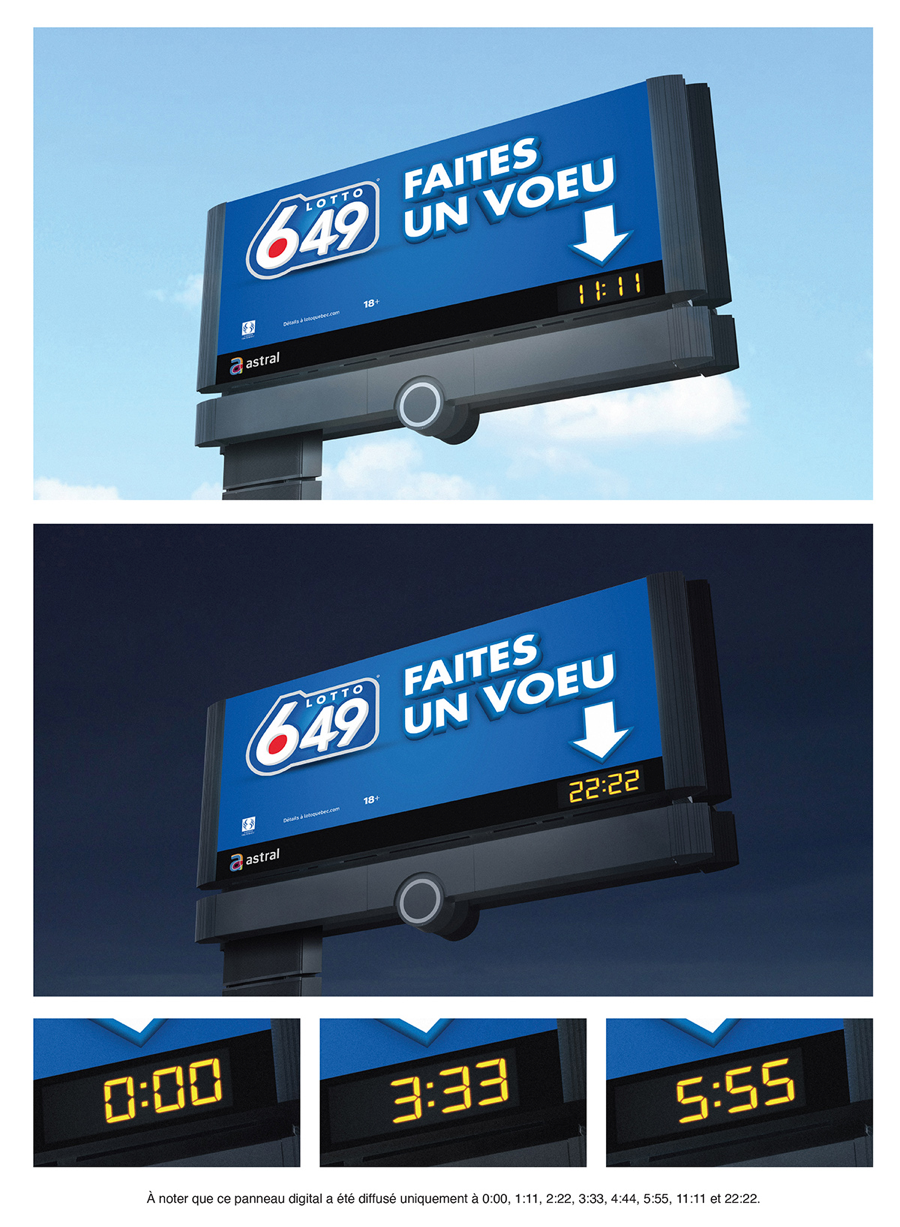
TV executions:
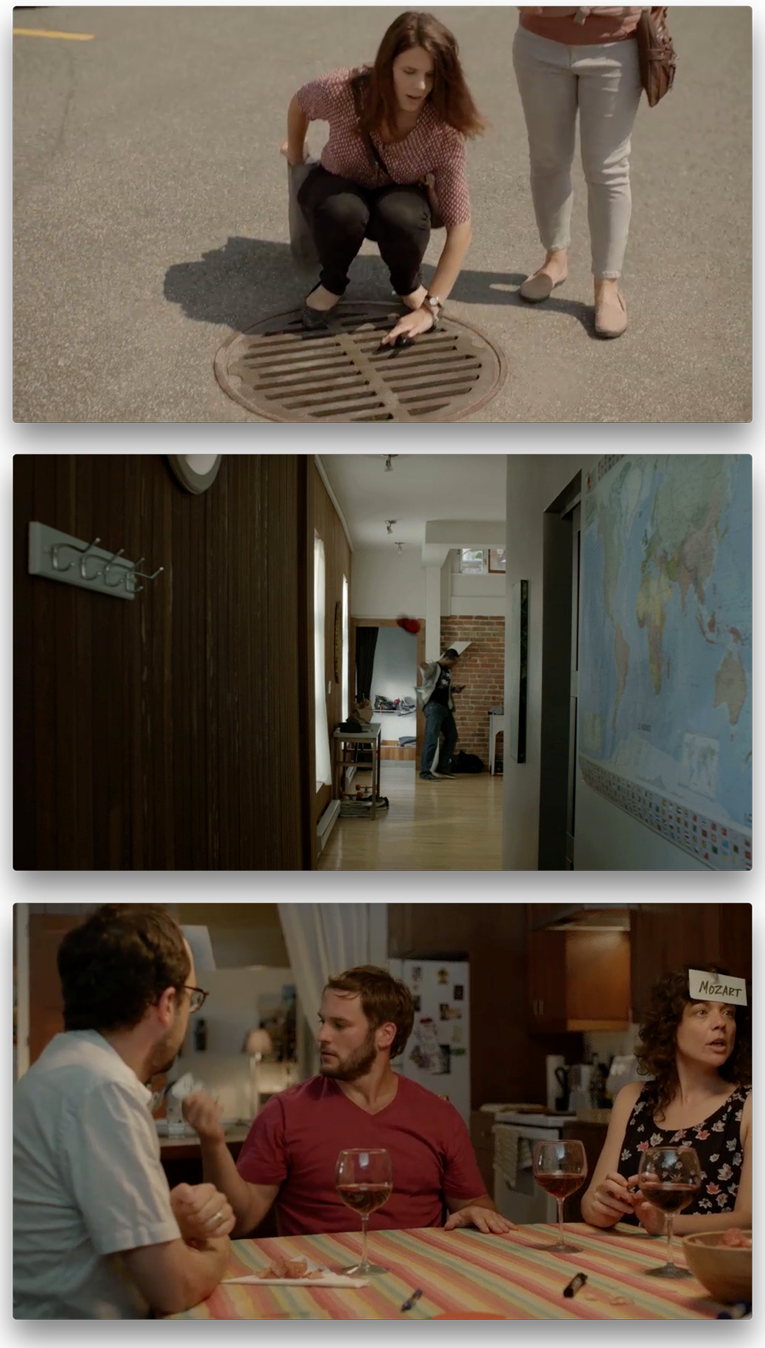
Radio spot on 12/12 at 12:12
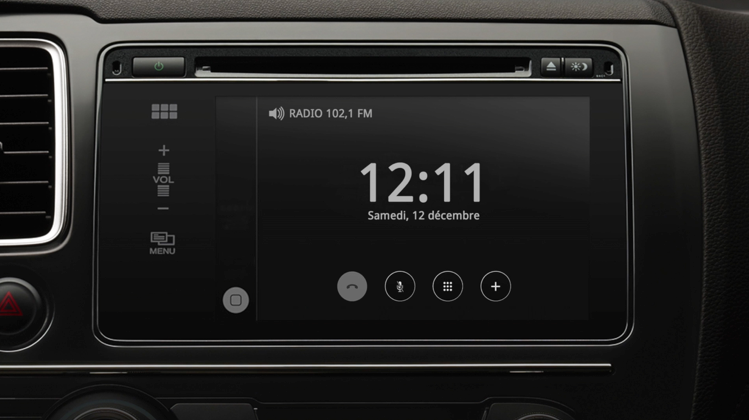
Social networks:
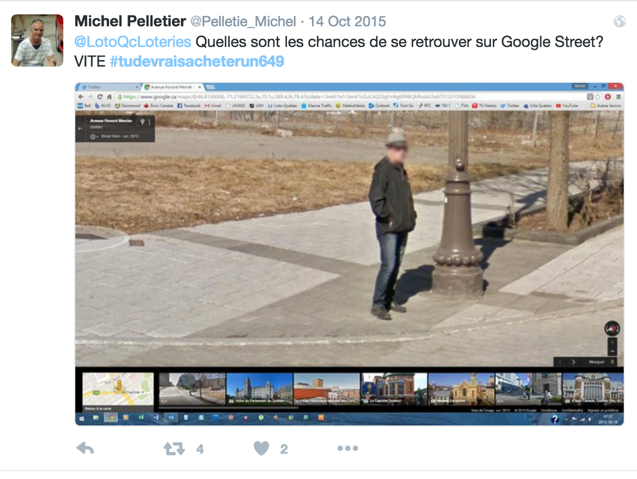
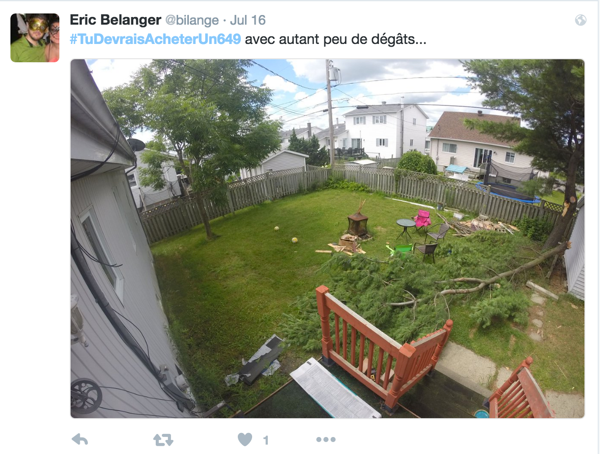
We built a communication platform where we featured a lucky moment in everyday life followed by the expression suggesting one should buy a Lotto 6/49. We created a series of short TV spots that showed everyday people in everyday situations experiencing a little unexpected luck. We set out to brand the lucky moments, by creating a catch phrase, I’ll take a 6/49 and the hashtag #youshouldbuya649. The way we built this communication platform makes the possibilities endless. We believe it can last for years, as there are too many lucky moments that happen in everyday life and that we can showcase in a Lotto 6/49 TV spot.
We worked in partnership with the Cogeco radio network to air a very short radio spot on December 12th at 12:12 inviting people to make a wish as their car clocks read 12/12 12:12.
We developed another partnership with digital billboard networks. We realized that every digital billboard in Quebec shows the time in the bottom right corner, so we invited people to make a wish when the billboard would display 1:11, 2:22, 3:33, etc.
We created an online promotion and contest inviting people to share their lucky moments using the hashtag #youshouldbuya649. Over a thousand stories were shared, generating thousands of social network engagement opportunities.
Since launching the platform in 2015, we have created and aired another series of six TV spots for Lotto 6/49. Beyond the strength of the pivotal insight that led to a successful repositioning of Lotto 6/49, we created a communication platform with endless possibilities that could last for years.
c) Media Plan Summary
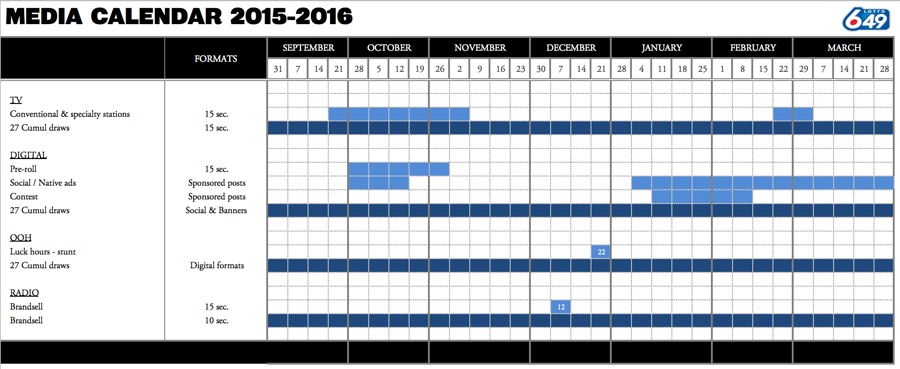
Section V — THE RESULTS
a) How did the work impact attitudes and behaviour?
Building relevancy
Millennials live busy lives and are targeted by every industry imaginable. Lotto 6/49 needed to create a deeper and more meaningful connection with Millennials without alienating its older customers.
Source: Ipsos ASI, November 2015 N=1,206
More than one in three Millennials could personally relate to the moments of chance that were exhibited in the several 15-second ads. This demonstrates a renewal of the relationship between Lotto 6/49 and this demographic based on a strong emotional connection.
Building brand recognition
The Lotto 6/49 brand is among the most recognized in the province of Quebec. Its level of awareness in Quebec has been capped at 99% for years, and yet the new campaign managed to have a spillover effect on Loto-Québec as a company by renewing Quebecers’ relationship with chance. In 2016, an increase of 8.0 points to Loto-Québec’s reputation score was attributed to the Lotto 6/49 campaign by Léger Marketing.
b) What Business Results did the work achieve for the client?
Stimulating sales with Millennials
From a high of 74% in 2011, the proportion of lottery ticket buyers with a frequency greater than once every three months among Millennials consistently declined for a decade to a low of 27% in 2015. Then, as we launched the campaign, Millennials not only noticed our ads, but started buying 6/49 lottery tickets again. The number of occasional and regular buyers jumped a record 29.6% in less than a year to reach 35%.
Source: Client data, June 2016
c) Other Pertinent Results
Stories that resonated
The hashtag #YouShouldBuyA649 (#TuDevraisAcheterUn649) really caught on, and two out of three Quebecers who heard about it believe it’s catchy. Within the first three weeks of campaign launch, more than a thousand stories were shared in response to our invitation, totalling 15,000+ engagements on Loto-Québec’s Facebook page.
The subject matter of the campaign and its perspective on everyday lucky moments resonated so strongly with Quebecers that three sketches from the Radio-Canada year-end Bye-Bye show parodied our TV spots.
d) What was the campaign’s Return on Investment?
Hard ROI
In the lottery industry, marketing investments between $1-3 million can help generate $10+ million dollars in revenues. From what sales figures shared by the clients indicate, we did generate a high return on investment. However, we cannot isolate for the exact effect of the marketing investment because of the randomness of jackpot sizes during the business results period, which can influence sales significantly.
Soft ROI
On top of stellar financial returns in 2015, what the campaign achieved is merely the rejuvenation of Quebecers’ relationship with chance. By showing common manifestations of chance, the campaign shifted the focus away from the probabilities of winning the lottery to the commonplace joy of being lucky. Only the future will tell if this new definition of chance will spread to the industry and benefit other brands like it did Lotto 6/49.
Section VI — Proof of Campaign Effectiveness
a) Illustrate the direct cause and effect between the campaign and the results
Source: Ipsos ASI
Lotto 6/49 TV advertising launched on September 28, 2015.
Result period: November 2-15, 2015
N = 1,206
We observed that over four out of five viewers appreciated the campaign ads, which confirms that our message was effective. What’s more? Only one in ten people experienced fatigue, which clearly demonstrates the strength and longevity of the connection viewers felt for our moments of chance narratives.
Source: Ipsos ASI
Lotto 6/49 TV advertising launched on September 28, 2015.
Result period: November 2-15, 2015
N = 1,206
Moving the needle in the lottery industry is very difficult because of its size and maturity stage. Nonetheless, when we take a closer look at purchase intentions, more than one in two Quebecers would certainly buy a Lotto 6/49, representing a jump of 8%. All purchase frequencies of regular and occasional buyers are also on the rise, indicating that we are moving in the right direction.
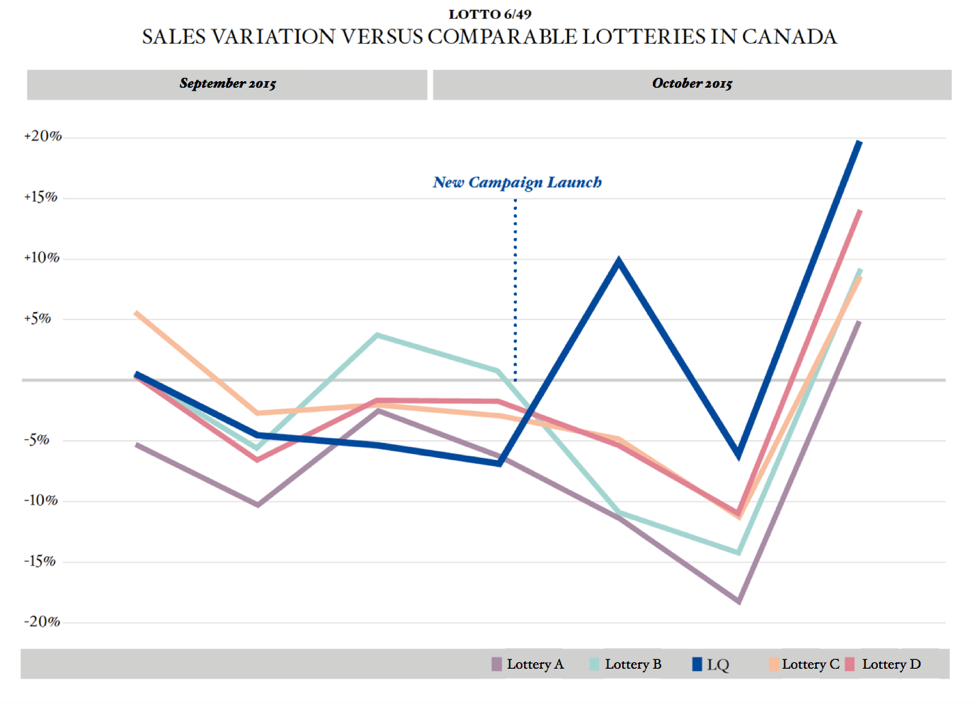
Source: Client sales data, September-October 2015
Even though lottery sales are generally linked to jackpot size, the new Lotto 6/49 campaign significantly increased Lotto 6/46 sales compared to the other provinces that promote the same lottery product.
b) Prove the results were not driven by other factors
Campaign spend vs. history and competition:
Loto-Québec did not spend more money advertising this promotional campaign in 2015 than it would have for any other promotional activities with media support for Lotto 6/49 in the past.
Pre-existing Brand momentum:
Lotto 6/49 did not have any upside momentum prior to the campaign that could have led to the observed results.
Pricing:
The price of lottery tickets varies only slightly from year to year, and Loto-Québec didn’t have any unusual price discounting during the campaign period.
Changes in Distribution/Availability:
Lotto 6/49 is distributed through a wide variety of retailers. The number of points of sale didn’t increase significantly during this period.
Unusual Promotional Activity:
Lotto 6/49 did not have any extraordinary promotional efforts during the campaign that could have led to the observed results.
Any other factors:
As Loto-Québec is in a situation of monopoly, there is no reason to believe that competition could have impacted the results.